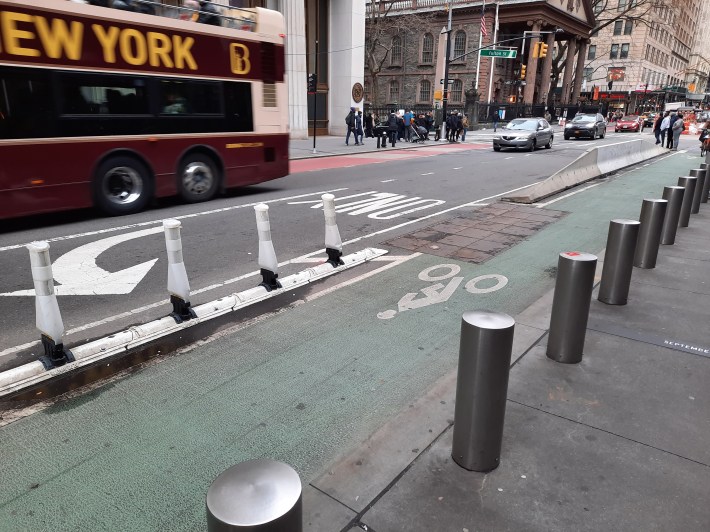Promises made — and made, and made, and made.
The city missed its legally required benchmarks for new protected bike and bus lanes for the second year in a row, the Adams administration revealed Thursday — while touting a lengthy list of street safety and transportation accomplishments most of which are still years in the future.
The city built a record 33 miles of new protected bike lanes in 2023, City Hall said — but that is still 17 miles below the 50-mile minimum per year under the City Council’s Streets Master Plan. Hizzoner fell short of the mandated green-painted paths in his first year in office in 2022 as well.
City Hall, DOT and several other city agencies sent out elaborate press releases on Thursday boasting a list of the year's "achievements" padded with announcements of plans instead of actually-completed work.
The mayor’s public relations victory lap was titled, “MAYOR ADAMS CONTINUES TO ‘GETS [sic] STUFF DONE’ FOR WORKING-CLASS NEW YORKERS HALFWAY THROUGH FIRST TERM,” and failed to mention any concrete policies enacted to improve service for bus riders, after coming in well below the required mileage of bus lanes last year.
In the end, the city installed fewer than 20 miles of new or enhanced bus lanes this year, according to an official familiar with the issue. Advocates said the number was closer to 14 miles. The mayor was obligated by law to build 30 miles of bus lanes this year.
DOT ignored several emails from Streetsblog on Thursday asking to verify the city's numbers, including how many bus lanes miles city officials believe they've built.
Adams last month dismissed the legal benchmarks during a bizarre speech at DOT headquarters, saying he cared more about vague notions of community feedback.
Advocates taking stock of the first half of the mayor’s four-year term expressed disappointment in the results or lack thereof, especially given the potential for major changes once congestion pricing begins next year.
“The mayor has no transportation policy or principles, so they’re duct-taping all this small-bore stuff including this pretty theoretical or thin potential stuff, and that’s what he has,” said Jon Orcutt, who worked at DOT under the Bloomberg administration and now leads advocacy and communications at Bike New York.
“A good mayor on city streets would have unveiled a big street safety program to go along with congestion pricing, and he’s wasted two years in not doing that."
DOT did not provide a detailed breakdown of the 33 miles or a list of locations for the new protected cycling infrastructure. A list compiled by advocates with Transportation Alternatives says the city built 29.6 miles for the year, while the state Department of Transportation built 2.4 miles of protected bike lanes under the Bruckner Expressway.
Ten of the city's new bike lane miles were in the Bronx, according to DOT, and the city also hardened 20 miles of existing protected bike lanes over the last two years — something Commissioner Ydanis Rodriguez had originally promised to accomplish in his first 100 days.

What's going on?
City Hall interfered repeatedly in marquee bike and street safety redesigns this year at the behest of powerful interest groups, such as McGuinness Boulevard, Ashland Place and Underhill Avenue — hobbling an agency that has suffered an exodus of high-skilled staff in recent years.
Mayor Adams also set up a rogue chain of command allowing his top adviser Ingrid Lewis-Martin to oversee DOT projects, much to the chagrin of agency staffers who want to get stuff done, as Streetsblog reported.

DOT did open high-quality new lanes for cyclists this year, such as the nearly 40 blocks of extra-wide paths on Third Avenue on the Upper East Side, about a mile of new paths on three Long Island City streets, and the Berry Street bike boulevard, showing what’s possible when the mayor lets the agency do its job.
Adams’s catalog also includes some notable accomplishments, like finally expanding summer streets to all boroughs, starting to containerize residential and business trash — albeit mostly still mostly by taking up scarce sidewalk space — and appointing the city’s first “chief public realm officer.”
The administration also celebrated being on track for an historic low in pedestrian fatalities this year, but overall crash deaths are among the highest in a decade, with a surge in cyclist deaths this year, and injuries are up across the board too, according to the latest police data.
Are these results or recycling?

Predominantly, the so-called achievements are announcements, not results, such as Adams promising to make 2,000 intersections safer next year, launching a plan for 40 miles of new greenways without a timeline or price tag, or restarting a “visioning process” to “reimagine” the much-delayed Fifth Avenue redesign in Midtown.
DOT also mentioned its pilot program to roll out 15 secure package lockers that were supposed to start "this summer" and got plenty of press coverage, but there's no evidence that any of those storage containers are live yet. (Again, the DOT declined to comment for this story seeking additional information about the agency's own press release.)
Under the sub-headline “making transportation more sustainable,” the mayor’s office listed milestones like Adams’s plan to lower the massive subsidy for the NYC Ferry by raising fares to $4, his controversial waiving of the cap on new ride-hail vehicles as long as they're electric, and plans for a maritime freight delivery facility at the Downtown Manhattan Heliport that won’t have to come online until the end of the decade.
There are also policy changes on the list that the mayor did sign into law, but came from the Council, such as the seasonal outdoor dining law, and the minimum pay rate for delivery workers. The release also lists speed and red light cameras ticketing drivers 24-7, which began last year after the state granted the enforcement program’s expansion.
Additional reporting by Dave Colon






